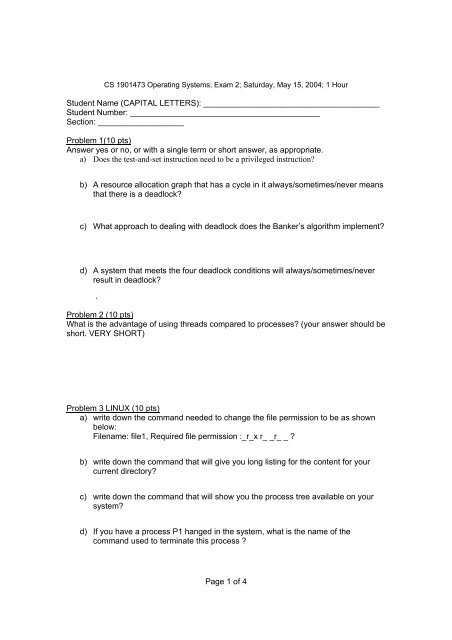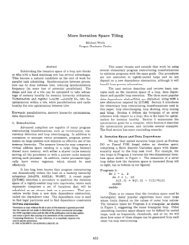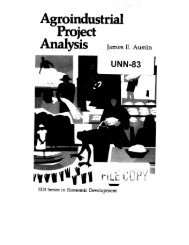PDF format
PDF format
PDF format
Create successful ePaper yourself
Turn your PDF publications into a flip-book with our unique Google optimized e-Paper software.
CS 1901473 Operating Systems; Exam 2; Saturday, May 15, 2004; 1 Hour<br />
Student Name (CAPITAL LETTERS): _______________________________________<br />
Student Number: __________________________________________<br />
Section: ___________________<br />
Problem 1(10 pts)<br />
Answer yes or no, or with a single term or short answer, as appropriate.<br />
a) Does the test-and-set instruction need to be a privileged instruction<br />
b) A resource allocation graph that has a cycle in it always/sometimes/never means<br />
that there is a deadlock<br />
c) What approach to dealing with deadlock does the Banker’s algorithm implement<br />
d) A system that meets the four deadlock conditions will always/sometimes/never<br />
result in deadlock<br />
.<br />
Problem 2 (10 pts)<br />
What is the advantage of using threads compared to processes (your answer should be<br />
short. VERY SHORT)<br />
Problem 3 LINUX (10 pts)<br />
a) write down the command needed to change the file permission to be as shown<br />
below:<br />
Filename: file1, Required file permission :_r_x r_ _r_ _ <br />
b) write down the command that will give you long listing for the content for your<br />
current directory<br />
c) write down the command that will show you the process tree available on your<br />
system<br />
d) If you have a process P1 hanged in the system, what is the name of the<br />
command used to terminate this process <br />
Page 1 of 4
Problem 4 (30 pts)<br />
a) (15 pts) Three processes share four resource units that can be reserved and<br />
released only one at a time. Each process acquires and releases resources over<br />
time but only needs a maximum of two resource units at any one time. Deadlock<br />
can not occur. Why<br />
b) (15 pts) Consider a system consisting of m resources of the same type, being<br />
shared by n processes. Resources can be requested and released by processes<br />
only 1 at a time. Show that the system is deadlock free if the following two<br />
conditions hold:<br />
(I) The max need for each process is between 1 and m resources.<br />
(II) The sum of all max needs is less than n + m.<br />
Problem 5 (15 pts)<br />
In lecture we said that, if the semaphore operations Wait and Signal are not executed<br />
atomically, then mutual exclusion may be violated. Assume that Wait and Signal are<br />
implemented as below:<br />
void Wait (Semaphore S) {<br />
while (S.count
Problem 6 (25 Points)<br />
Consider a system that has W workers and M managers that continuously enter and<br />
leave an office. Work can only be done in teams consisting of 1 manager and 2 workers<br />
in the office. The detailed requirements are:<br />
• Managers arrive to a FCFS queue, and workers arrive to their own FCFS queue.<br />
• When the manager at the front of the queue is ready, he/she picks the next two<br />
workers for his team and tells them to begin working. Then, the next manager<br />
can form his/her team in a similar manner.<br />
• Workers tell their manager when they are done working and leave immediately.<br />
• A manager does not leave until all team members have said they are leaving.<br />
• After work is completed, the team members leave for a random amount of time<br />
before re turning.<br />
a) Describe the synchronization for the manager process by writing the manager<br />
process in terms of the counting semaphore primitives Signal() and Wait() and<br />
the semaphore and variable declarations. Note: You do not need to give the<br />
worker process code; i.e., you can assume that the worker process is given.<br />
b) Describe the use of each semaphore and the general logic of the manager<br />
process. You can do that using comments in your code.<br />
HINT: (Note: You may use the following skeleton.)<br />
struct {<br />
int manager;<br />
int worker[2];<br />
int n=0;<br />
} newTeam;<br />
// shared<br />
// manager of new team<br />
// which workers are forming a new team<br />
// how many entries in worker[2]<br />
... semaphore definitions ...<br />
Page 3 of 4
process manager (i) {<br />
int myTeam[2];<br />
// who is on my team<br />
}<br />
do forever {<br />
... code ...<br />
}<br />
process worker (i) {<br />
... NOT NEEDED ...<br />
}<br />
Page 4 of 4














![Problem 1: Loop Unrolling [18 points] In this problem, we will use the ...](https://img.yumpu.com/36629594/1/184x260/problem-1-loop-unrolling-18-points-in-this-problem-we-will-use-the-.jpg?quality=85)

